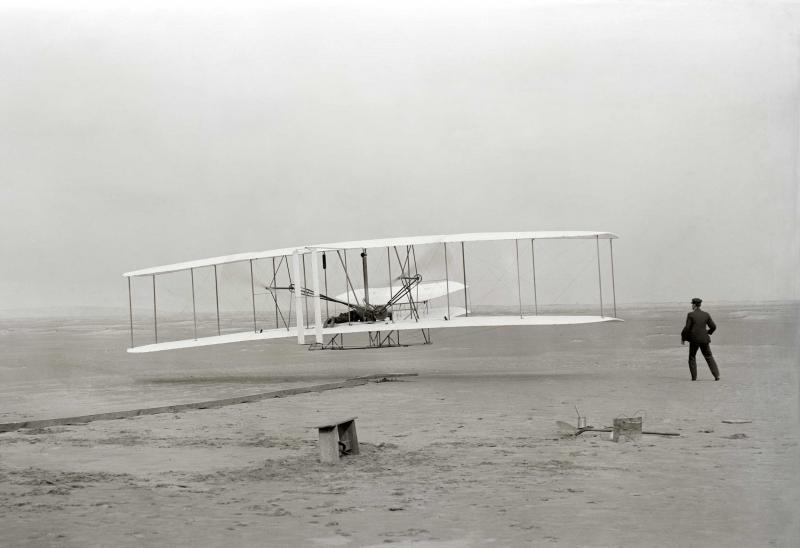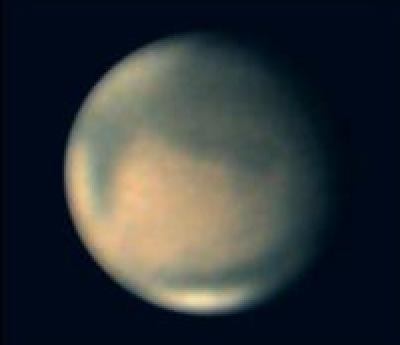The first Martian helicopter flights & Kitty Hawk
2021 May 31
At the start of the twentieth century, the concept of flying machines was hardly a new idea. Balloon ascents were common, and gliders had already made short flights. Two BAA members, the Rev John Bacon and his daughter Gertrude, had even made a balloon ascent to watch the Leonid meteors in 1899 November. But powered flight had not yet been attained.
The brothers Orville and Wilbur Wright had begun experimenting with the idea of aviation in their bicycle shop in Dayton, Ohio, as early as 1896. On 1903 Dec 17 – with the benefit of an 82kg engine that was designed and built by themselves, a new propeller and plenty of experience gliding the previous year – they made the first-ever powered flights, near the fishing village of Kitty Hawk, North Carolina, USA. Historical precedence had been decided by the toss of a coin. The first successful heavier-than-air flight – by Orville – lasted just 12 seconds, but on the fourth attempt, with Wilbur at the controls, the aircraft stayed aloft for 59 seconds and covered a stretch 260 metres in length. Their success was an epochal moment in modern aviation, and their original flying machine is part of the Smithsonian collection.

The landing of the Perseverance rover by NASA on 2021 Feb 18 was referred to by the BAA President in the last Journal [131(2), 67 (2021)]. It had been narrowly preceded to the Red Planet by two other missions: on Feb 9 the UAE Space Agency probe Hope went into orbit, followed the very next day by a spacecraft from China, Tianwen-1. The China and USA missions comprise an orbiter, lander and rover. The UAE mission involved insertion into a highly elliptical orbit, which at closest approach usefully corresponds to a geostationary path, and at its furthest facilitates whole-planet imaging.
The sky-crane landing technique used by NASA again proved successful, and the rover has since been exploring Jezero crater (18°N, 282°W). But the most remarkable development occurred two months after arrival. On Apr 16, the Ingenuity helicopter successfully completed a spin test without taking off. Then, on Apr 19, the first helicopter to have been carried to Mars attempted the first powered flight upon another world, while Perseverance waited and watched from 65 metres away.
With counter-rotating blades revolving at 2,500rpm to gain lift in the thin Martian air, the 11kg craft rose about three metres, took images of the ground and its own shadow, then landed again after a flight lasting some 40 seconds (Figure 1). There had been few people on that windswept beach to witness the Wright brothers’ flight (Figure 2), but the short hop of Ingenuity drew a global audience.
On Apr 22, a second flight took place and this time it also moved sideways by several metres before landing safely. As I finish this note, more ambitious flights are planned.
To complete the historic link with the Wright brothers, a minute piece of muslin that had covered one of the wings from the Wright brothers’ Flyer 1 was attached to a cable beneath Ingenuity’s solar panel. And we shall conclude with another link, by presenting one historic observation from our archives for 1903 (Figure 3) and one very recent one (Figure 4), both showing the hemisphere in which Jezero is located.


Useful English-language website links for the three latest Mars missions are given below.
en.wikipedia.org/wiki/Tianwen-1
Richard McKim, Director, BAA Mars Section
https://britastro.org/wp-content/uploads/2021/06/Figure-4-2.JPG
https://britastro.org/wp-content/uploads/2021/06/Figure-4-2.JPG
https://britastro.org/wp-content/uploads/2021/06/Figure-4-2.JPG
https://britastro.org/wp-content/uploads/2021/06/Figure-4-2.JPG
https://britastro.org/wp-content/uploads/2021/05/Figure-4-2.JPG
https://britastro.org/wp-content/uploads/2021/06/Figure-4-2.JPG
https://britastro.org/wp-content/uploads/2021/06/Figure-4-2.JPG
https://britastro.org/wp-content/uploads/2021/06/Figure-4-2.JPG
https://britastro.org/wp-content/uploads/2021/06/Figure-4-2.JPG
https://britastro.org/wp-content/uploads/2021/06/Figure-4-2.JPG
https://britastro.org/wp-content/uploads/2021/06/Figure-4-2.JPG
https://britastro.org/wp-content/uploads/2021/06/Figure-4-2.JPG
https://britastro.org/wp-content/uploads/2021/06/Figure-4-2.JPG
https://britastro.org/wp-content/uploads/2021/06/Figure-4-2.JPG
https://britastro.org/wp-content/uploads/2021/06/Figure-4-2.JPG
| The British Astronomical Association supports amateur astronomers around the UK and the rest of the world. Find out more about the BAA or join us. |
